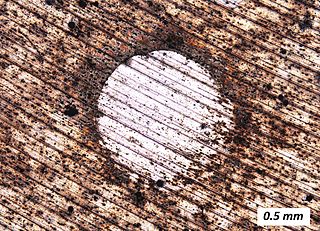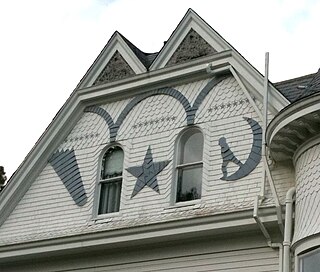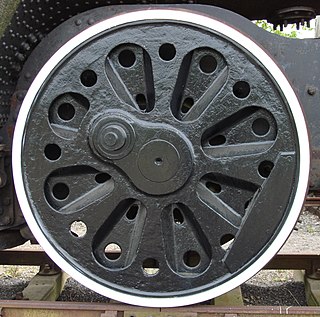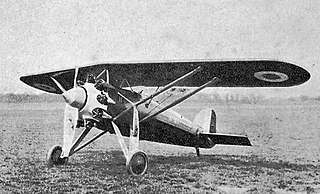Related Research Articles

Monocoque, also called structural skin, is a structural system in which loads are supported by an object's external skin, in a manner similar to an egg shell. The word monocoque is a French term for "single shell".

Plywood is a composite material manufactured from thin layers, or "plies", of wood veneer that are glued together with adjacent layers, having both glued with each other at right angle or at 90 degrees angle. It is an engineered wood from the family of manufactured boards, which include medium-density fibreboard (MDF), oriented strand board (OSB), and particle board.

Duralumin is a trade name for one of the earliest types of age-hardenable aluminium–copper alloys. The term is a combination of Dürener and aluminium. Its use as a trade name is obsolete. Today the term mainly refers to aluminium-copper alloys, designated as the 2000 series by the international alloy designation system (IADS), as with 2014 and 2024 alloys used in airframe fabrication.

Aéroplanes Morane-Saulnier was a French aircraft manufacturing company formed in October 1911 by Raymond Saulnier and the Morane brothers, Léon and Robert. The company was taken over and diversified in the 1960s.

The Morane-Saulnier M.S.406 is a French fighter aircraft developed and manufactured by Morane-Saulnier starting in 1938. It was France's most numerous fighter during the Second World War and one of only two French designs to exceed 1,000 in number. At the beginning of the war, it was one of only two French-built aircraft capable of 400 km/h (250 mph) – the other being the Potez 630.

The mechanical structure of an aircraft is known as the airframe. This structure is typically considered to include the fuselage, undercarriage, empennage and wings, and excludes the propulsion system.

Boat building is the design and construction of boats and their systems. This includes at a minimum a hull, with propulsion, mechanical, navigation, safety and other systems as a craft requires.

A rivet is a permanent mechanical fastener. Before being installed, a rivet consists of a smooth cylindrical shaft with a head on one end. The end opposite the head is called the tail. On installation, the deformed end is called the shop head or buck-tail.

Siding or wall cladding is the protective material attached to the exterior side of a wall of a house or other building. Along with the roof, it forms the first line of defense against the elements, most importantly sun, rain/snow, heat and cold, thus creating a stable, more comfortable environment on the interior side. The siding material and style also can enhance or detract from the building's beauty. There is a wide and expanding variety of materials to side with, both natural and artificial, each with its own benefits and drawbacks. Masonry walls as such do not require siding, but any wall can be sided. Walls that are internally framed, whether with wood, or steel I-beams, however, must always be sided.

In materials science, a metal foam is a material or structure consisting of a solid metal with gas-filled pores comprising a large portion of the volume. The pores can be sealed or interconnected. The defining characteristic of metal foams is a high porosity: typically only 5–25% of the volume is the base metal. The strength of the material is due to the square–cube law.

In materials science, a sandwich-structured composite is a special class of composite materials that is fabricated by attaching two thin-but-stiff skins to a lightweight-but-thick core. The core material is normally of low strength, but its greater thickness provides the sandwich composite with high bending stiffness with overall low density.

An aluminium alloy (UK/IUPAC) or aluminum alloy is an alloy in which aluminium (Al) is the predominant metal. The typical alloying elements are copper, magnesium, manganese, silicon, tin, nickel and zinc. There are two principal classifications, namely casting alloys and wrought alloys, both of which are further subdivided into the categories heat-treatable and non-heat-treatable. About 85% of aluminium is used for wrought products, for example rolled plate, foils and extrusions. Cast aluminium alloys yield cost-effective products due to the low melting point, although they generally have lower tensile strengths than wrought alloys. The most important cast aluminium alloy system is Al–Si, where the high levels of silicon (4–13%) contribute to give good casting characteristics. Aluminium alloys are widely used in engineering structures and components where light weight or corrosion resistance is required.

Alclad is a corrosion-resistant aluminium sheet formed from high-purity aluminium surface layers metallurgically bonded to high-strength aluminium alloy core material. It has a melting point of about 500 °C (932 °F). Alclad is a trademark of Alcoa but the term is also used generically.

Honeycomb structures are natural or man-made structures that have the geometry of a honeycomb to allow the minimization of the amount of used material to reach minimal weight and minimal material cost. The geometry of honeycomb structures can vary widely but the common feature of all such structures is an array of hollow cells formed between thin vertical walls. The cells are often columnar and hexagonal in shape. A honeycomb-shaped structure provides a material with minimal density and relative high out-of-plane compression properties and out-of-plane shear properties.

The Morane-Saulnier MS.230 aircraft was the main elementary trainer for the French Armée de l'Air throughout the 1930s. Almost all French pilots flying for the Armée de l'Air at the outbreak of World War II had had their earliest flight training in this machine. It was the equivalent of the Stearman trainer in the United States air services and the de Havilland Tiger Moth in the British Royal Air Force.

The Morane-Saulnier MS.570 was a civil utility aircraft produced in small numbers in France in the late 1940s.
Carbon fiber-reinforced polymers, carbon-fibre-reinforced polymers, carbon-fiber-reinforced plastics, carbon-fiber reinforced-thermoplastic, also known as carbon fiber, carbon composite, or just carbon, are extremely strong and light fiber-reinforced plastics that contain carbon fibers. CFRPs can be expensive to produce, but are commonly used wherever high strength-to-weight ratio and stiffness (rigidity) are required, such as aerospace, superstructures of ships, automotive, civil engineering, sports equipment, and an increasing number of consumer and technical applications.

The SNCAO 200, sometimes written as CAO.200, was a French single-seat fighter aircraft prototype of the 1930s. It was a single-engined monoplane intended to compete with the Dewoitine D.520, but it was unsuccessful, and only one was built.

Lightening holes are holes in structural components of machines and buildings used by a variety of engineering disciplines to make structures lighter. The edges of the hole may be flanged to increase the rigidity and strength of the component. The holes can be circular, triangular, elliptical, or rectangular and should have rounded edges, but they should never have sharp corners, to avoid the risk of stress risers, and they must not be too close to the edge of a structural component.

The Morane-Saulnier MS.224 was a prototype fighter plane built by Morane-Saulnier in the early 1930s.
References
- 1 2 3 4 "History". venesta.co.uk. Retrieved 17 July 2020.
- ↑ Wainwright, Oliver (12 July 2017). "Beneath the veneer: our unbending fascination with plywood". The Guardian.
- ↑ Castanie, Bruno; Bouvet, Christophe; Ginot, Malo (13 July 2020). "Review of Composite Sandwich Structure in Aeronautic Applications". Composites Part C: Open Access.
- ↑ Mason, Richard (November 2017). "The Mark of Morane: Morane-Saulnier M.S.406". Scale Aircraft Modelling.
- ↑ Piancastelli, Luca; Frizziero, Leonardo; G., Zanuccoli; Daidzic, Nihad E.; I., Rocchi (2013). "A comparison between CFRP and 2195-FSW Materials for Aircraft Structural Designs". International Journal of Heat and Technology. 31: 17–24.
- ↑ Alari, Ann (15 August 2017). "A look at Estonia through plywood: the material of the modern world". estonianworld.com.